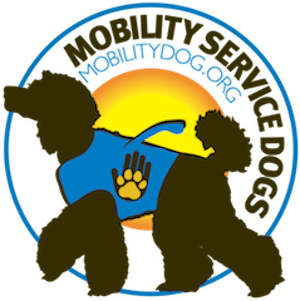Agency and the Ethics of the Dog-Human Relationship – Part 1
Young Woman and Brown Dog Playing (Courtesy: Image by Zigmars Berzins from Pixabay)
Modern canines evolved in response to environmental pressures and opportunities. Many of the latter arose from their association with humans. The relationship between dogs and humans developed as a kind of symbiosis, with people and animals both benefitting from interaction with the other.
This relationship was accelerated by the discovery we humans could employ the evolving wolf-dog in a variety of ways – hunting, guarding and companionship, for example. As humans, dogs and societies all evolved; the ways we employ dogs today has also evolved – guiding, mobility support, emotional support and therapy, for instance.
Medical Alert Dog and Handler (Courtesy: MobilityDog.org)
Are Working Dogs Just Slaves?
When we train a dog to perform a specific job we have defined and to behave as we command, have we merely enslaved a sentient being? Humans, after all, are almost always in a position of power over a dog – are we abusing that power by making them do our bidding?
Consider that dogs seek and are fulfilled by human contact. That characteristic evolved as the dogs that most successfully bonded with early humans lived better lives than their more standoffish counterparts. While individual dogs vary in personality and in propensity to connect with people, the vast majority of canines derive a positive experience from their contact with humans. They want to associate with us.
Moreover, giving a dog a job to do need not be exploitive. Research has shown that for dogs, as with humans and other trainable animals, learning is a positive experience and being able to earn one’s rewards is gratifying. When conditions are right (proper forms of training and conscientious care), dogs and people form effective co-worker teams, with both parties profiting.
Giving Dogs Agency
Do some dog trainers use aversive methods to coerce dogs to perform? Sadly, yes. Are some dog handlers indifferent to the mental and physical condition of their canine partners? Again, the answer is an unfortunate yes. Although these problems are rare, we need to be clear about what responsibilities accompany asking a dog to perform a job. In Part 2 of this blog, we will consider the specific requirements for ethical and compassionate training and treatment of our canine co-workers. Here, we will focus on a key requirement for canine well-being: agency.
What is Agency for a Dog?
For any sentient being, including homo sapiens and Canis lupus familiaris, having agency means:
Exercising control over individual choices.
Having individual needs and preferences respected.
Dogs don’t have complete autonomy over every aspect of their lives. Granting a dog complete freedom to roam would, for most animals, lead to disaster. Rather, in practical terms, agency for a dog means that the responsible humans have granted the animal the greatest possible degree of choice over the elements that define their lives and their partnerships with people.
Here are some examples of the ways conscientious caregivers can increase their dogs’ sense of agency.
An Adult and Puppy German Shepherd Playing Outside (Courtesy: Image by Anja from Pixabay)
Living space – To the extent possible, giving a dog freedom to explore a home and a yard lets them employ their basic instinct to investigate their surroundings. For their safety and the safety of others in the home environment, some places may need to be off-limits. However, the freedom to sniff around gives Princess more access to interesting information and more control over her perceived domain.
Interactions with people and dogs – Canines are social by nature and derive pleasure from contact with people and other pups. Of course, some dogs are more extroverted than others, so specific personality traits must be recognized and honored. Nonetheless, well-managed interactions enrich dogs’ lives and respect their fundamental need to connect.
Recreation – Letting a dog choose its toys and have control over its play are important aspects of agency. Equally, when your dog tires of an activity – deciding to lie in the shade rather than return the ball again – respect that.
Exploration – Walking a dog is part exercise and part enrichment, with a dollop of potential social interaction thrown in. Naturally, different animals need different amounts of exercise and handle exertion differently, according to their age, condition and physical traits. Older dogs, chubbier pooches and brachycephalic dogs (e.g., flat-faced breeds) tolerate heat and extended exertion poorly – recognize the dog’s condition and calibrate your walks and other exercise accordingly.
Don’t Exploit, Objectify or Instrumentalize
Instead, we should recognize what fulfills our dogs and enhances the quality of their lives. Our goal should be the enrichment of the time they have as our co-workers and pets. Achieving this objective not only enables them to flourish but also makes them the best possible partners in the jobs we do together.



